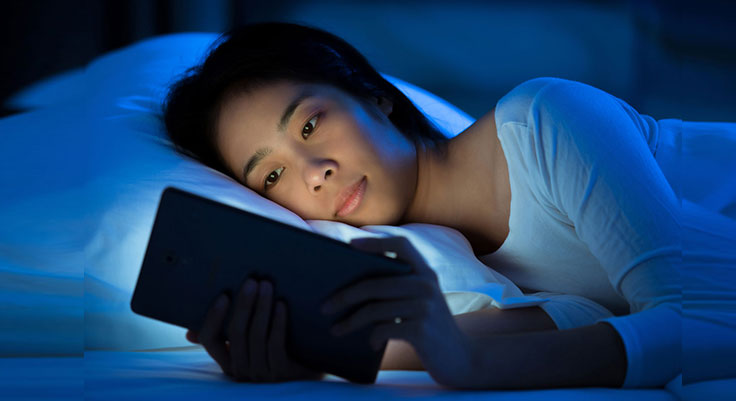
Blue Light and Its Effects on Our Skin
Blue light is a colour in the visible light spectrum that can be seen by the human eye. Blue light is also known as high energy light since it has the highest energy. One of the best ways to understand this light is through the sky. The blue colour of the sky is imparted by the collision of high and low energy blue rays, that are visible to the human eye.
Blue light is considered harmful and affects various parts of our body.
The Brain
The brain is arguably one of the most affected. We spend veritably all day on the screen, using a variety of devices to get through work, our daily life and even depend on screens for relaxation. Screens emit all the colours in light – violet, indigo, blue, green, yellow, orange and red – aka VIBGYOR. The blue light is the most dangerous emission since our brain interprets blue light as indicative of daytime. Since the brain is genetically programmed to help us function efficiently during the day, and considers it productive hours, when it interprets the blue light of the screen, it does not realise the passage of time and the incoming of night. Thus, the brain stops releasing melatonin, aka the sleep hormone. This in turn disturbs our circadian rhythm that is set by nature and commanded by natural light.
To counter this effect, begin by practicing to not use your screens at least an hour before you go to sleep. You can also work on fitting your surrounding with warm colours of the light. Yellow light and red light are considered to be the best for bedside lamps. Avoid blue lights as far as possible when trying to sleep.
The Eyes
This high use of screens and increased exposure to blue light also deeply affects our eyes. We run the risk of macular degeneration, a retinal disease of great concern. While age related macular degeneration is prevalent, the issue is often exacerbated by use of screens.
You can protect your eyes by making regular use of sunglasses. Often, our screens come with a blue light filter you can choose to activate as well as timed night light settings, both of which are recommended. Follow the 20-20-20 rule: after 20 minutes of exposure to any screen, shift your gaze away and focus on something at least 20 feet away. Focus on the object or point for 20 seconds and then blink 20 times. Also go for regular eye check ups and ensure to follow all precautions mentioned by your doctor.
Mental Health
In general, all electronic devices such as phones, computers, tablets etc emit blue light, which is detrimental to our health. Blue light also affects our mental wellbeing. It may cause increased sense of anxiety and depressive feelings in a person due to overexposure and subsequent disruption of the natural circadian rhythm of our body.
With regards to our skin, blue light does not bring much of good news. Exposure to blue light also adversely affects our skin. Long exposure of high energy of blue light can lead to a variety of skin issues, ranging from damage to our DNA, to issues with skin barrier, photoaging and eye damage. Prolonged and intense exposure brings more serious issues to the forefront.
Advanced effects include dark circles, causing strain to the eye. It also leads to premature aging and signs of aging grow more visible and more obvious. Insomnia from blue light exposure leads to dullness of the skin and a loss of glow. One also suffers from skin discolouration, inflammation and weakening of the tissues. Perhaps the most alarming issues are the oxidative stress, loss of laxity of skin, hyperpigmentation and melasma.
To protect the skin from the harmful and damaging effects of blue light, use sunscreen with a broader SPF. Make the use of sunscreen a regular practice, especially if you spend long hours in the sun as part of your daily life. While almost everyone knows about using sunscreen with the natural rays of the sun, one should also use it while using screens. Thus, apply sunscreen with a broader SPF when using a screen round the clock, every hour.
Blue Light Therapy for Acne
While blue light and exposure to blue is definitively harmful for us, technology and science have found ways to harness the light in a useful manner as well. Blue light therapy is a modern procedure that is used to work on skin diseases. Low energy and low exposure of this usually higher energy of light can be used to treat for acne.
Blue light therapy, when used properly, reduces activity in our sebaceous or oil glands. When production of oil lessens, there is no plugging of sebum in our pores and hair follicles. Since clogging of the pores is the cause of acne and its symptoms, once the root issue is resolved, acne is effectively treated as well. Blue light therapy also works in treating another kind of acne. With the use of this technique, we can kill Cutibacterium acnes as well.
Blue light therapy should be administered across sessions, usually ranging from two to five sessions for effective results without harmful side effects. These sessions should be spaced out to allow the treatment to work. A gap of two to four weeks is recommended when opting for this treatment option.